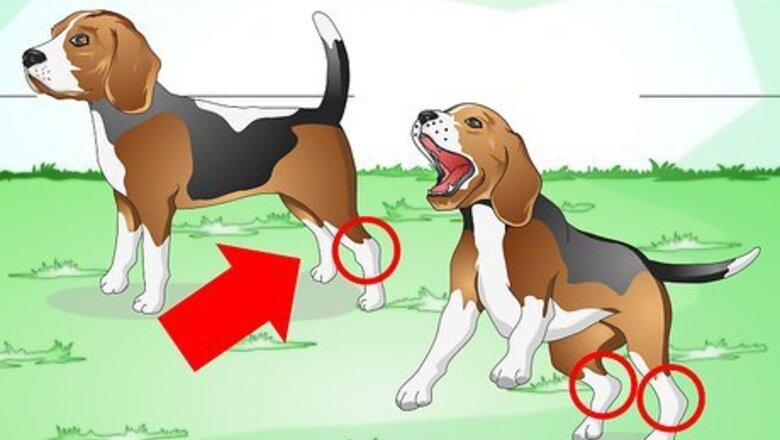
views
Recognizing the Signs of a Sprained Ankle
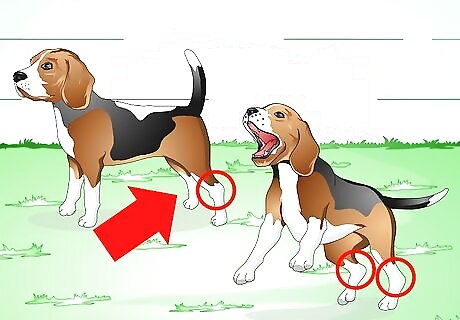
Understand your dog's anatomy. Dogs actually stand and walk on the toes of their front and rear legs. When a dog is standing, you will see their ankle on their hind leg between the knee and the toes. This is similar to where your ankle is when you stand on your toes. Dogs do not have ankles on their front legs, just as you don't have ankles on your arms. Other types of sprains can occur in the front legs, and they are treated similarly.
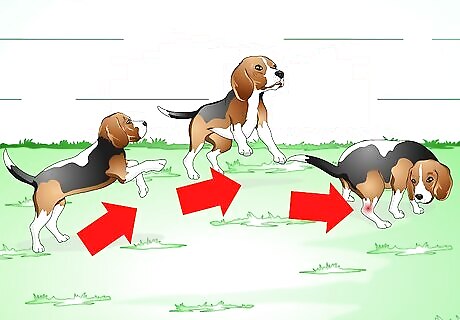
Know the causes of a sprained ankle. Many dogs are athletic. The activities they take part in can put an extreme amount of force and stress on their joints. This sometimes results in an injury. Running, jumping, and making sharp and quick turns can put undue stress on a joint. While not all dogs are equally energetic, their joints can also be put under more stress than they can handle. A sprain can also be the result of slipping, falling, stepping in a hole, or something as seemingly minor as jumping on or off the couch. Any of these can cause your dog to end up with a sprain.

Look for limping. The first, and usually the most recognizable, sign of an ankle sprain is limping on the affected rear leg. A dog with a sprain will often try not to put weight on the affected leg. Depending on the severity of the sprain, the dog may carry the leg in a raised position and not use it at all. Be aware of other common reasons for rear leg lameness. Injuries to the hip, knee, or foot can also cause a dog to limp. Take your dog to the vet to confirm that they have a sprained ankle. A vet can use radiographs to make sure there are no fractures or dislocations. They'll also try to rule out other possible causes of the injury.
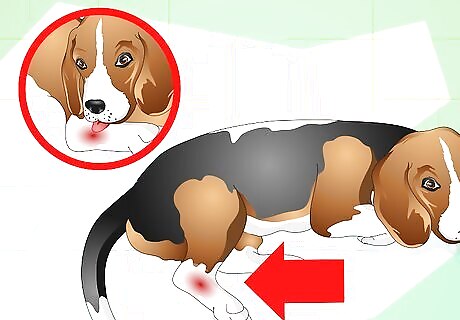
Look for a visible injury. You may see swelling or redness around the ankle or feel heat coming from the area if your dog has a sprain. You may also notice your dog regularly licking the area.
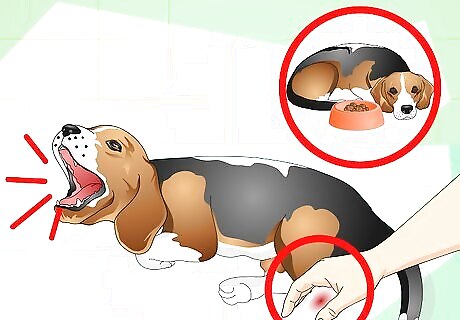
Look for behavioral signs. An injured dog may also display changes in their normal behavior. Changes to look for that can suggest a sprained ankle include: A change in their appetite, usually apparent in decreased food consumption. A change in their activity level, such as sleeping more or a reluctance to exercise. Vocalization related to the injury, such as barking, grunting, or whining when the ankle is touched or moved.
Treating a Sprained Ankle
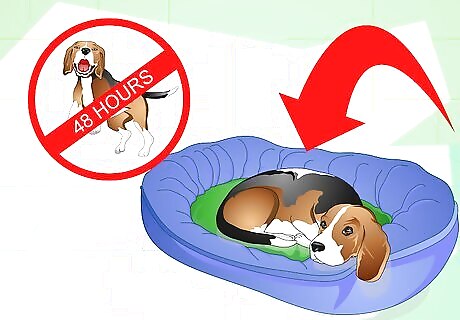
Make your dog rest. Rest is the first step to treating a sprain. To ensure your dog gets enough rest, you will need to restrict your dog's activity. You should keep your dog inside or in a small area where they are unable to run or play. The less active your dog is, the better. As needed, you can take your dog outside on a short leash. Keep the walk short and slow. Return your dog to a confined area as soon as possible. Restrict your dog's activity for a full 48 hours to give the injury enough time to heal. EXPERT TIP Colleen Demling-Riley, CPDT-KA, CBCC-KA, CDBC Colleen Demling-Riley, CPDT-KA, CBCC-KA, CDBC Canine Behavior Consultant Colleen Demling-Riley (CPDT-KA, CBCC-KA, CDBC) is a Canine Behavior Consultant and the Founder of Pawtopia Dog Training. With more than 20 years of experience, she specializes in creating and customizing dog management programs for dog owners. She is a Certified Pet Dog Trainer-Knowledge Assessed, Certified Behavior Consultant Canine-Knowledge Assessed, Certified Dog Behavior Consultant, and American Kennel Club Canine Good Citizen Evaluator. Colleen is a member of the International Association of Canine Professionals and has been a featured expert in national media including the New York Times, Woman’s Day, Readers Digest, Cosmopolitan, and Yahoo.com. Colleen Demling-Riley, CPDT-KA, CBCC-KA, CDBC Colleen Demling-Riley, CPDT-KA, CBCC-KA, CDBC Canine Behavior Consultant When your dog is having health issues, give them extra care and attention. Make your dog as comfortable as possible. Put them on a soft bed or blankets in a quiet spot where they can rest peacefully, like a crate in a quiet corner of the family room. Give them space and avoid forcing them to walk or play. These comforting gestures can make a big difference in how your dog feels while they're sick or uncomfortable.
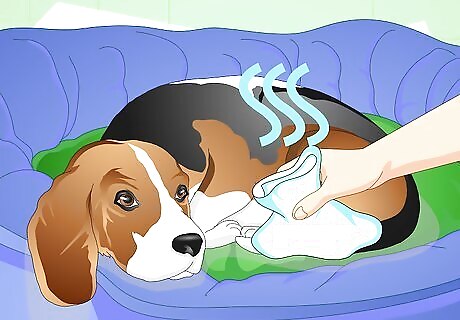
Apply an ice pack. To reduce swelling to the ankle, help with pain, and aid in the healing process, apply an ice pack on your dog’s ankle for 10 to 15 minutes. Wrap the ice pack in a towel to protect your dog's skin from the cold. Repeat twice daily, waiting at least 2 hours between applications. This helps prevent you from irritating your dog’s skin and reducing their circulation, which can delay healing. You can use a bag of frozen vegetables, such as peas, in place of an ice pack. This helps you mold the ice around their ankle, allowing you to evenly and effectively apply the ice to all of the damaged tissue.
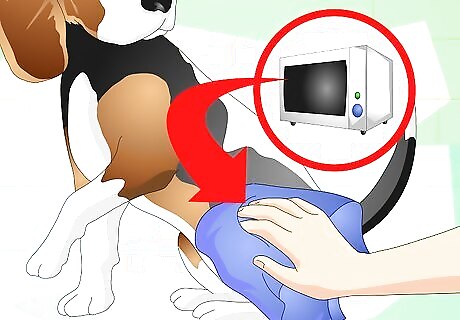
Apply heat. If your dog’s ankle is no longer swollen, heat therapy can help reduce their pain, increase circulation, and limit stiffness. Swelling typically goes down after 72 hours. Applying heat is often recommended for dogs who have a chronic or recurring ankle sprain. To apply a warm compress, heat a damp towel or a dry sock filled with uncooked rice in the microwave. Test the towel or sock on your inner arm to ensure it’s not too hot. Then, apply the heat for 10 to 15 minutes. Reapply the warm compress every 6 to 8 hours. Don't use a heat treatment while your dog’s ankle is swollen or immediately after exercise, as this can increase inflammation.
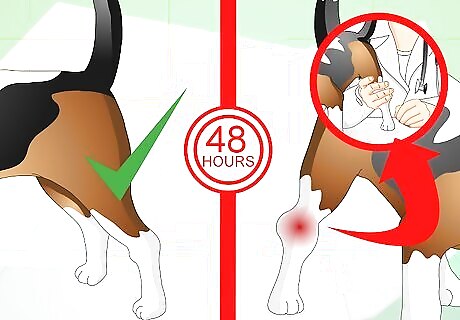
Watch for signs of improvement or worsening. During your dog’s 48-hour rest period, watch them closely for signs that their ankle injury is improving or worsening. With rest, ice, and heat, many mild ankle sprains heal on their own. If your dog’s ankle is not better after 48 hours, or if it gets worse, call and visit your veterinarian. At your veterinarian appointment, your vet will do a physical examination to diagnose the sprain. They might do an X-ray to determine the severity of the sprain or see if another injury, like a dislocation or small fracture, is delaying your dog’s recovery. After diagnosing your dog’s sprain, your vet will give you a treatment plan. If the sprain is mild, this might involve more rest or veterinarian-prescribed anti-inflammatory medication. If the sprain is moderate or severe, your vet might recommend a splint or surgery.




















Comments
0 comment